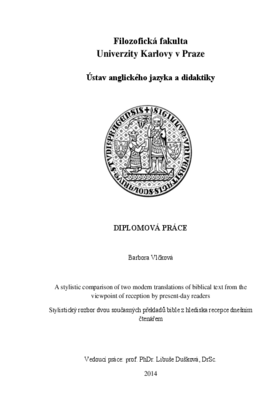A stylistic comparison of two modern translations of biblical text from the viewpoint of reception by present-day readers
Stylistický rozbor dvou současných překladů bible z hlediska recepce dnešním čtenářem
diplomová práce (OBHÁJENO)

Zobrazit/
Trvalý odkaz
http://hdl.handle.net/20.500.11956/63053Identifikátory
SIS: 127361
Katalog UK: 990017853780106986
Kolekce
- Kvalifikační práce [24991]
Autor
Vedoucí práce
Oponent práce
Popelíková, Jiřina
Fakulta / součást
Filozofická fakulta
Obor
Anglistika - amerikanistika
Katedra / ústav / klinika
Ústav anglického jazyka a didaktiky
Datum obhajoby
27. 5. 2014
Nakladatel
Univerzita Karlova, Filozofická fakultaJazyk
Angličtina
Známka
Výborně
Klíčová slova (česky)
Bible, styl, stylistika, náboženský jazyk, čtenářKlíčová slova (anglicky)
Bible, style, stylistics, language of religion, readerDiplomová práce se zabývá dvěma současnými překlady Bible do angličtiny, jimiž jsou New American Standard Bible, představující konzervativní překlad Bible, a Good News Bible, překlad volnější, usilující o čtivost a dostupnost z hlediska dnešního čtenáře. Cílem práce je zanalyzovat tyto dva překlady co do stylu a rozhodnout, jakých jazykových prostředků využívá překlad Good News Bible k dosažení vyšší působivosti na čtenáře. Výzkum je založen na vzorku 100 obsahem si odpovídajících veršů z každé Bible (dohromady 200 veršů). Verše reprezentují pět různých narativních částí Bible. Syntaktická rovina je zkoumána jak kvalitativně, tak kvantitativně, lexikální rovina pak pouze kvalitativně. Diplomová práce se snaží výsledky výzkumu nejen popsat, ale také je pokud možno vysvětlit.
The present thesis deals with two present-day English translations of the Bible - New American Standard Bible, which represents a conservative biblical translation, and Good News Bible, a more liberal translation, written in a way to be readable and accessible to the modern reader. The aim of the thesis is to analyze the two translations in terms of style, focusing on the syntactic and lexical levels. The research is based on a sample of 100 corresponding biblical verses drawn from each of the translations (altogether 200 verses), representing five different narrative parts of the Bible. The analysis of the lexical level is a qualitative one, comparing the nature of the vocabulary used in the two translations; the syntactic level is examined both qualitatively and quantitatively. The thesis attempts not only to describe the findings but also account for them, where possible, in terms of reader reception.
